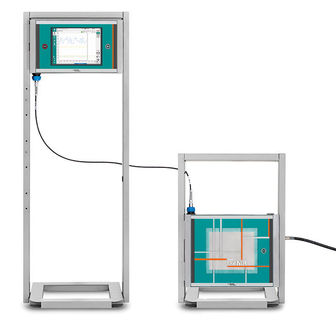Crigler-Najjar Syndrome
Classification & external resources
|
|
| Bilirubin
|
| ICD-10
| E80.5
|
| ICD-9
| 277.4
|
| OMIM
| 218800 606785
|
| DiseasesDB
| 3176
|
| MedlinePlus
| 001127
|
| eMedicine
| med/476
|
| MeSH
| D003414
|
Crigler-Najjar Syndrome or CNS is a rare disorder affecting the metabolism of bilirubin, a chemical formed from the breakdown of blood. The disorder results in an inherited form of non-hemolytic jaundice, often leading to brain damage in infants. This syndrome is divided into two types: type I and type II, which is sometimes called Arias syndrome. These two types, along with Gilbert's syndrome, make up the three known hereditary defects in bilirubin metabolism. Unlike Gilbert's syndrome, only a few hundred cases of CNS are known to exist.
Crigler-Najjar syndrome, type I
This is a very rare disease (estimated at 0.6 - 1.0 per million live births), and consanguinity increases the risk of this condition (other rare diseases may also be present). Inheritance is autosomal recessive.
Intense jaundice appears in the first days of life and persists thereafter. Type 1 is characterised by a serum bilirubin usually above 345 µmol/L (310 - 755) (whereas the reference range for total bilirubin is 2 - 14 μmol/L).
No UGT1A1 expression can be detected in the hepatic tissue. Hence, there is no response to treatment with phenobarbital[1] (which causes enzyme induction). Most patients (type IA) have a mutation in one of the common exons (2 to 5), and have difficulties conjugating several additional substrates (several drugs and xenobiotics). A smaller percentage of patients (type IB) have mutations limited to the bilirubin-specific A1 exon; their conjugation defect is mostly restricted to bilirubin itself.
Prior to the availability of phototherapy, these children died of kernicterus (=bilirubin encephalopathy), or survived until early adulthood with clear neurological impairment. Today, therapy includes
- exchange transfusions in the immediate neonatal period,
- 12h/d phototherapy
- heme oxygenase inhibitors to reduce transient worsening of hyperbilirubinemia (although the effect decreases over time)
- oral calcium phosphate and -carbonate to form complexes with bilirubin in the gut,
- liver transplantation prior to the onset of brain damage, and before phototherapy becomes ineffective at later age
Crigler-Najjar syndrome, type II
Differs from type I in several aspects:
- bilirubin levels are generally below 345 µmol/L (100 - 430; thus, there is overlap), and some cases are only detected later in life
- because of lower serum bilirubin, kernicterus is rare in type II
- bile is pigmented, instead of pale in type I or dark as normal, and monoconjugates constitute the largest fraction of bile conjugates
- UGT1A1 is present at reduced but detectable levels (typically <10% of normal), because of single base pair mutations
- therefore, treatment with phenobarbital is effective, generally with a decrease of at least 25% in serum bilirubin. In fact, this can be used, along with these other factors, to differentiate type I and II.
Inheritance is generally considered autosomal dominant.
Differential diagnosis
Neonatal jaundice may develop in the presence of sepsis, hypoxia, hypoglycemia, hypothyroidism, hypertrophic pyloric stenosis, galactosemia, fructosemia, and so on.
Hyperbilirubinemia of the unconjugated type may be caused by
- increased production
- decreased clearance
In Crigler-Najjar syndrome and Gilbert syndrome, routine liver function tests are normal, and hepatic histology usually is too. There is no evidence for hemolysis. Drug-induced case typically regress after discontinuation of the substance. Physiological neonatal jaundice may peak at 85 - 170 µmol/L, and decline to normal adult concentrations within 2 weeks. Prematurity results in higher levels.
Experimental treatments
One 10-year-old girl with Crigler-Najjar syndrome type I was successfully treated by hepatocyte transplantation.[2]
The homozygous Gunn rat, which lacks the enzyme uridine diphosphate glucuronyltransferase (UDPGT), is an animal model for the study of Crigler-Najjar syndrome. Since there is only one enzyme working improperly, gene therapy for Crigler Najjar is a theoretical option which is being investigated.
Eponym
The condition is named for JF Crigler Jr and VA Najjar.[3][4][5]
See also
References
- ^ Jansen PL. Diagnosis and management of Crigler-Najjar syndrome. Eur J Pediat 1999; 158 S2; S89-94. PMID 10603107
- ^ Fox IJ, Roy Chowdhury J, Kaufman SS, Goertzen TC, Roy Chowdhury N, Warkentin PI, Dorko K, Sauter BV, Strom SC. Treatment of the Crigler-Najjar syndrome type I with hepatocyte transplantation. N Engl J Med 1998; 338: 1422-1426. PMID 9580649
- ^ Crigler JF Jr, Najjar VA. Congenital familial nonhemolytic jaundice with kernicterus; a new clinical entity. AMA Am J Dis Child 1952;83:259-60. PMID 14884759
- ^ Crigler JF Jr, Najjar VA. Congenital familial nonhemolytic jaundice with kernicterus. Pediatrics 1952;10:169-80. PMID 14884759
- ^ synd/86 at Who Named It
| Metabolic pathology / Inborn error of metabolism (E70-90, 270-279) |
|---|
| Amino acid | Aromatic (Phenylketonuria, Alkaptonuria, Ochronosis, Tyrosinemia, Albinism, Histidinemia) - Organic acidemias (Maple syrup urine disease, Propionic acidemia, Methylmalonic acidemia, Isovaleric acidemia, 3-Methylcrotonyl-CoA carboxylase deficiency) - Transport (Cystinuria, Cystinosis, Hartnup disease, Fanconi syndrome, Oculocerebrorenal syndrome) - Sulfur (Homocystinuria, Cystathioninuria) - Urea cycle disorder (N-Acetylglutamate synthase deficiency, Carbamoyl phosphate synthetase I deficiency, Ornithine transcarbamylase deficiency, Citrullinemia, Argininosuccinic aciduria, Hyperammonemia) - Glutaric acidemia type 1 - Hyperprolinemia - Sarcosinemia |
|---|
| Carbohydrate | Lactose intolerance - Glycogen storage disease (type I, type II, type III, type IV, type V, type VI, type VII) - fructose metabolism (Fructose intolerance, Fructose bisphosphatase deficiency, Essential fructosuria) - galactose metabolism (Galactosemia, Galactose-1-phosphate uridylyltransferase galactosemia, Galactokinase deficiency) - other intestinal carbohydrate absorption (Glucose-galactose malabsorption, Sucrose intolerance) - pyruvate metabolism and gluconeogenesis (PCD, PDHA) -
Pentosuria - Renal glycosuria |
|---|
| Lipid storage | Sphingolipidoses/Gangliosidoses: GM2 gangliosidoses (Sandhoff disease, Tay-Sachs disease) - GM1 gangliosidoses - Mucolipidosis type IV - Gaucher's disease - Niemann-Pick disease - Farber disease - Fabry's disease - Metachromatic leukodystrophy - Krabbe disease
Neuronal ceroid lipofuscinosis (Batten disease) - Cerebrotendineous xanthomatosis - Cholesteryl ester storage disease (Wolman disease) |
|---|
| Fatty acid metabolism | Lipoprotein/lipidemias: Hyperlipidemia - Hypercholesterolemia - Familial hypercholesterolemia - Xanthoma - Combined hyperlipidemia - Lecithin cholesterol acyltransferase deficiency - Tangier disease - Abetalipoproteinemia
Fatty acid: Adrenoleukodystrophy - Acyl-coA dehydrogenase (Short-chain, Medium-chain, Long-chain 3-hydroxy, Very long-chain) - Carnitine (Primary, I, II) |
|---|
| Mineral | Cu Wilson's disease/Menkes disease - Fe Haemochromatosis - Zn Acrodermatitis enteropathica - PO43�' Hypophosphatemia/Hypophosphatasia - Mg2+ Hypermagnesemia/Hypomagnesemia - Ca2+ Hypercalcaemia/Hypocalcaemia/Disorders of calcium metabolism |
|---|
Fluid, electrolyte
and acid-base balance | Electrolyte disturbance - Na+ Hypernatremia/Hyponatremia - Acidosis (Metabolic, Respiratory, Lactic) - Alkalosis (Metabolic, Respiratory) - Mixed disorder of acid-base balance - H2O Dehydration/Hypervolemia - K+ Hypokalemia/Hyperkalemia - Cl�' Hyperchloremia/Hypochloremia |
|---|
| Purine and pyrimidine | Hyperuricemia - Lesch-Nyhan syndrome - Xanthinuria |
|---|
| Porphyrin | Acute intermittent, Gunther's, Cutanea tarda, Erythropoietic, Hepatoerythropoietic, Hereditary copro-, Variegate |
|---|
| Bilirubin | Unconjugated (Lucey-Driscoll syndrome, Gilbert's syndrome, Crigler-Najjar syndrome) - Conjugated (Dubin-Johnson syndrome, Rotor syndrome) |
|---|
| Glycosaminoglycan | Mucopolysaccharidosis - 1:Hurler/Hunter - 3:Sanfilippo - 4:Morquio - 6:Maroteaux-Lamy - 7:Sly |
|---|
| Glycoprotein | Mucolipidosis - I-cell disease - Pseudo-Hurler polydystrophy - Aspartylglucosaminuria - Fucosidosis - Alpha-mannosidosis - Sialidosis |
|---|
| Other | Alpha 1-antitrypsin deficiency - Cystic fibrosis - Amyloidosis (Familial Mediterranean fever) - Acatalasia |
|---|
|







